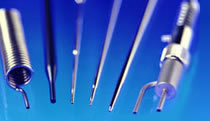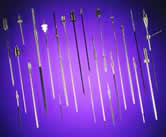|
Services
Include
Abrasive Flow Honing Assembly Brazing Bending, Coiling, Forming Finishing, Coating Laser Processing Services Passivation, Cleaning Precision Cutting Precision Machining Swaging, Flaring, Bulging
 
ISO 9001:2008 |
About Tubing
There are a few basic essentials to consider when designing a tubular part: the size, the material, the temper, and finally the method used to draw the tube.
For stainless steel tube sizes there are two different kinds of tubing, hypodermic gage and fractional tubing. Fractional tubing is made to common fractional sizes, for example ¼" outside diameter (O.D.) x .035" wall. When discussing the size of a fractional tube we talk about the OD and the wall thickness. This is different from hypodermic or what is commonly referred to as needle tubing. Hypodermic tubing is referred to by gage size. Gage sizes are determined by the outside diameter and the inside diameter of a tube. Please see the fractional tube chart as well as a hypodermic gage tube chart to assist you. The sizes on these charts are mostly readily available. We also stock many odd sizes that are will not be found on the charts. Please contact us if your needs may require a custom size or if you have any questions.
When choosing the right material for an application there are many things that need to be considered. Here at New England Small Tube the majority of materials we work with are 300 series stainless steel, specifically 304 and 316. We also frequently work with copper, brass, Inconel, and titanium. Please refer to our materials section for more information on each of these alloys. We will be happy to assist in choosing the right material for your application.
The next consideration when choosing the proper tubing is temper. Temper is how hard a tube is and it is measured by the tensile strength. Generally off-the-shelf hypodermic tubing is full hard and off-the-shelf fractional tubing will be annealed (soft). Please see the chart below for reference. Temper is an important consideration if an application requires bending.
Temper (Tensile Strength)
|
| Full Hard |
½ Hard |
Annealed |
| > 140,000 PSI |
120,000-140,000 PSI |
< 120,000 PSI |
The last consideration when choosing a tube is how the tube was drawn or made. The three basic methods or types of tubing are seamless, welded, and welded & drawn. Seamless tubing is made by punching a hole through a billet and drawing the material to size.This method can be used to form very thin walled tubing or very thick walled tubing as welded material starts with a flat sheet that is then rolled and welded creating a rather noticeable seam. Welded & drawn tubing starts the same way, however it is plug drawn. That means a plug is put through the inside of the tube to smooth out the seam. If necessary this step can be done multiple times to produce a better finish on the I.D.
|
|


